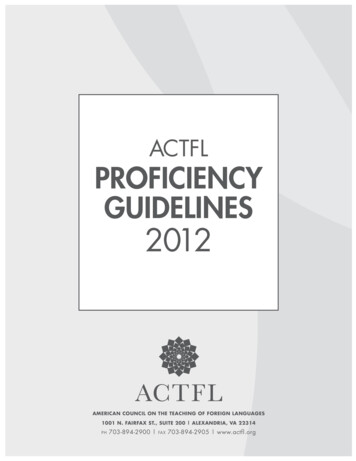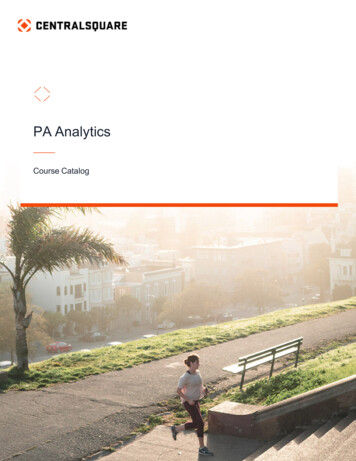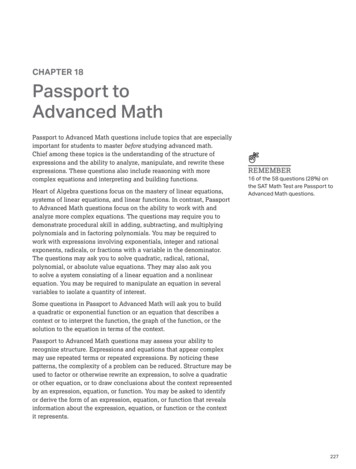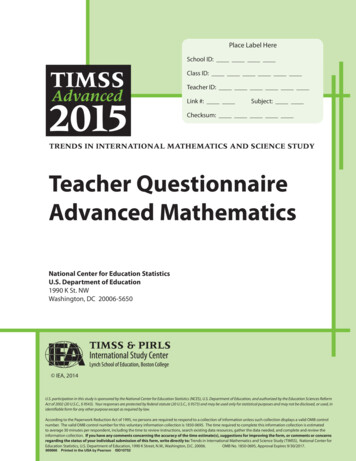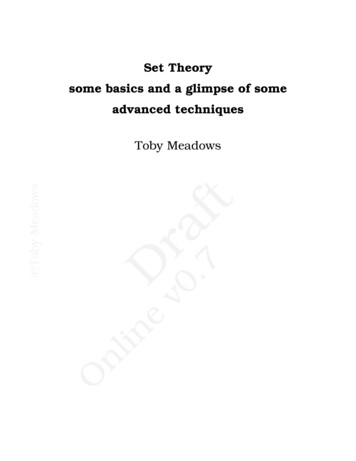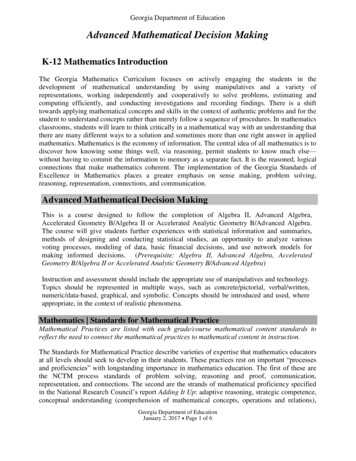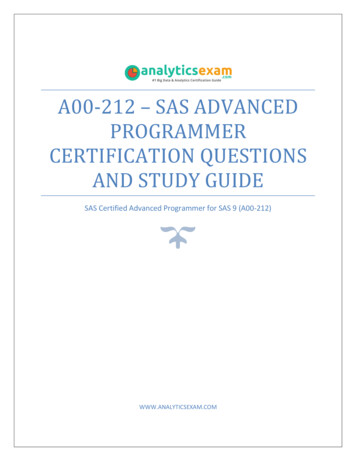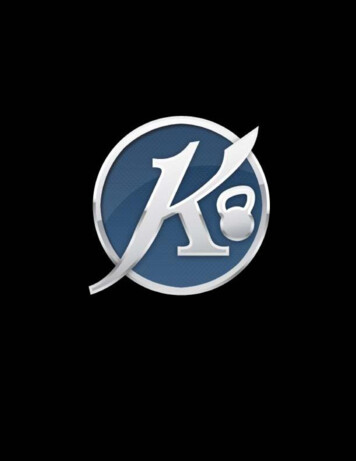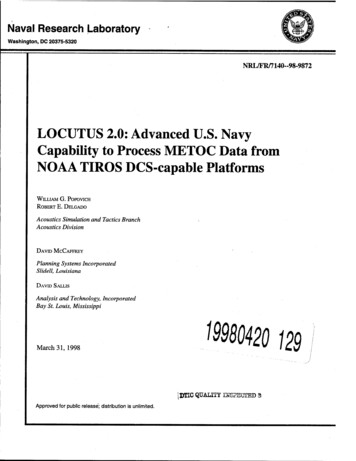
Transcription
Naval Research LaboratoryWashington, DC 20375-5320NRL/FR/7140--98-9872LOCUTUS 2.0: Advanced U.S. NavyCapability to Process METOC Data fromNOAA TIROS DCS-capable PlatformsWILLIAM G. POPOVICHROBERT E. DELGADOAcoustics Simulation and Tactics BranchAcoustics DivisionDAVID MCCAFFREYPlanning Systems IncorporatedSlidell, LouisianaDAVID SALLISAnalysis and Technology, IncorporatedBay St. Louis, MississippiA f\f\ A A A MLMarch 31, 19981995042(11 291- - . J[lyriC QUALITY BSEPEtTEED 3Approved for public release; distribution is unlimited.i
Form ApprovedOMBNO.Q704-0188REPORT DOCUMENTATION PAGEPublic reporting burden for this collection of information is estimated to average 1 hour per response, including the time for reviewing instructions, searching existing data sources,gathering and maintaining the data needed, and completing and reviewing the collection of information. Send comments regarding this burden estimate or any other aspect of thiscollection of information, including suggestions for reducing this burden, to Washington Headquarters Services, Directorate for Information Operations and Reports, 1215 JeffersonDavis Highway, Suite 1204, Arlington, VA 22202-4302, and to the Office of Management and Budget, Paperwork Reduction Project (0704-0188), Washington, DC 20503.1. AGENCY USE ONLY (Leave BlanK)2. REPORT DATEMarch 31,19983. REPORT TYPE AND DATES COVEREDFinal4. TITLE AND SUBTITLE5. FUNDING NUMBERSLOCUTUS 2.0: Advanced U.S. Navy Capability to Process METOC Data from NOAA TIROSDCS-capable Platforms64218N6. AUTHOR(S)William G. Popovich, Robert E. Delgado, David McCaffrey,* and David Sallis**7. PERFORMING ORGANIZATION NAME(S)AND ADDRESS(ES)8. PERFORMING ORGANIZATIONREPORT NUMBERNaval Research LaboratoryWashington, DC 20375-5320NRL/FR/7140-98-98729. SPONSORING/MONITORING AGENCY NAME(S) AND ADDRESS(ES)Commander, Space and Naval Warfare Systems CommandMETOC Systems Program Office, PMW185San Diego, CA 92110-3127The Oceanographer of the Navy(CNO-N096)United States Naval ObservatoryWashington, DC 20392-542110. SPONSORING/MONITORINGAGENCY REPORT NUMBER11. SUPPLEMENTARY NOTES Planning Systems, Inc. Analysis and Technology, Inc.12a. DISTRIBUTION/AVAILABILITY STATEMENT12b. DISTRIBUTION CODEApproved for public release; distribution unlimited.13. ABSTRACT {Maximum 200 words)Since January 1992, scientists from the Acoustics Division of the Naval Research Laboratory have made great advances in theability to receive, decode, and display METOC data using NOAA TTROS DCS-capable satellite receiving stations. Using in-house orcommercial off-the-shelf equipment arid government-furnished LOCUTUS 2.0 software, it is now possible to receive, decode, display, and report METOC data from a wide variety of DCS-capable transmitters, including U.S. Navy fixed and drifting oceanographic buoys, automatic weather observation stations, and high-tech experimental buoys. Complete postprocessing of all sensordata and accurate range-rate position fixing of drifting buoys are performed routinely and automatically, completely independent ofexternal data processing. Local satellite "footprint" data reception is accomplished using several Navy satellite receiver systems,both VHF and S-band. Worldwide transmitter coverage from the TTROS GAC-1A telemetry link is also routinely provided. Projectsponsorship and resources are provided by the NRL Tactical Oceanography Warfare Support program office and the SPAWARMETOC Systems program office.14. SUBJECTTERMSSonobuoyOceanographyMeteorology17. SECURITY CLASSIFICATIONOF REPORTUNCLASSIFIEDNSN 7540-01-280-550015. NUMBER OF PAGESAntisubmarine warfareTESS 3Acoustics18. SECURITY CLASSIFICATIONOFTHIS PAGEUNCLASSIFIEDSatelliteTelemetry19. SECURITY CLASSIFICATIONOFABSTRACTUNCLASSIFIED2616. PRICE CODE20. LIMITATION OF ABSTRACTULStandard Form 298 (Rev. 2-89)Prescribed by ANSI Std 239-18298-102
CONTENTSLOCUTUS DESCRIPTION1LOCUTUS PROJECT HISTORY2TESS-3 INTEGRATION4LOCUTUS SPREAD TO COTS METOC SATELLITE RECEIVING SYSTEMS6VHF Local User Terminal (NAVOCEANO and NDBC)TELONICS T-RIS SHF Satellite Receiving SystemHRPT Image Processing System (GLOBAL Imaging, Inc.) at National Hurricane CenterU.S. Navy Satellite Data Receiving and Processing System (SDRPS)6777DECODING OF DCS-CAPABLE TRANSMITTER TECHNICAL FILES BY LOCUTUS8LOCUTUS GRAPHICAL USER INTERFACE8WORLDWIDE TIROS GAC/LAC CAPABILITY10POSITIONING ALGORITHM11SHAREM EXERCISES12HURRICANE HUNT 1995.13GUAM TYPHOON BUOY DATA15GULF OF MEXICO INSHORE CIRCULATION EXPERIMENT15RECOMMENDATIONS FOR FUTURE SYSTEM IMPROVEMENT17ACKNOWLEDGMENTS20REFERENCES20ACRONYM LIST21Preceding Page Blankiii
LOCUTUS 2.0: ADVANCED U.S. NAVY CAPABILITY TO PROCESSMETOC DATA FROM NOAA TffiOS DCS-CAPABLE PLATFORMSLOCUTUS DESCRIPTIONLOCUTUS 2.0 is software that receives, decodes, and displays environmental data using selectedmeteorological and oceanographic (METOC) satellite receiver systems. Developed at the Naval ResearchLaboratory's facility at Stennis Space Center, Bay St. Louis, Mississippi, LOCUTUS is written in the Cprogramming language with X-Windows/Motif style graphics for the UNIX operating system. Thesoftware enables users of these selected systems to process digital data from UHF transmitter devicescompatible with the data collection system (DCS) transceiver aboard the National Oceanic andAtmospheric Administration's (NOAA) TIROS satellite. These data may be environmental, METOC, ordiagnostic, depending on the construction of the device. The devices are called platform transmitterminals (PTT) and are designed and operated within specifications agreed upon by internationalagreement, with the major parties being the United States (via NOAA) and France (via Le Centre NationalDEtudes Spatiales (CNES)). This agreement stipulates a standard digital data format for all PTTs andprovides guidelines for receiving and processing data. PTT users, who have no in-house satellite receivingequipment capable of direct reception and processing of TIROS DCS telemetry, can purchase custom dataprocessing, PTT location service, and data delivery from Service ARGOS, Inc. By the same agreement, allusers of DCS-compatible PTTs must pay a service fee to Service ARGOS, Inc. for the right to be assignedDCS identification numbers. The agreement allows for control of the volume of PTT transmissionsthrough TIROS satellites, preventing saturation of the DCS transceivers.A thriving industry has evolved in the manufacture of a huge variety of waterborne buoys, current/tidemeters, animal trackers, weather stations, and similar devices incorporating passive measurementequipment and the standard TIROS DCS-compatible PTT. The allotment and arrangement of the devices'sensors and internal diagnostic meters within a 256-bit DCS uplink message has been termed the formator the technical file of the device. The technical specification of the DCS signal and DCS word has beenan international standard for decades and is listed in publications both from NOAA and Service ARGOS,Inc. [1]. The important features of the specification are the frequency (401.65 0.4 MHz short term), datarate (400 bps), polarization (linear and right-circular), carrier modulation (phased-shift keyed), datamodulation (split phase-Manchester code), and power requirements of the signal plus the length,arrangement, and stop/start bit patterns of the uplink word [2]. Having satisfied these PTT parameters, thedesigner of an environmental or METOC measuring device incorporating a DCS-capable PTT to telemeterthe data must arrange external sensors and internal diagnostic equipment in the device to assuremechanical and electronic compatibility with the PTT. The limitation imposed by the standard of 32 eightbit words of a DCS message is the paramount limitation in the design and construction of a PTT-bearinginstrument. PTT circuitry can be tightly manufactured to occupy a volume of just a few cubic inches. Thisminiaturization allows great flexibility in the design and manufacture of measurement devicesincorporating a PTT to telemeter sensed data to TIROS.Manuscript approved November 17,1997.
Popovich et al.Since the 1970s, several commercial TIROS satellite receiving systems have been successfullymanufactured and marketed in the Western world, with the capability to independently process, Earthlocate, and deliver PTT data relayed through the TIROS DCS transceiver. Some systems receive DCS datafrom the TIROS VHF double sideband digital downlink; others strip out the DCS data from the TIROShigh resolution picture transmission (HRPT) S-band telemetry stream. All of these systems deliver thePTT data in alphanumeric ASCII form with little or no graphics enhancement. No commercial systemdelivers capability to process and display PTT data from the taped-data orbital dump from the TIROSglobal area coverage (GAC-1A) S-band downlink signal. LOCUTUS 2.0 was developed in response todemand from the Navy for real-time, at-sea reception of METOC data from Navy-operated fixed anddrifting PTTs for operational tactical use. Over the course of four years of intense engineeringdevelopment, graphic presentation of METOC data from PTTs using LOCUTUS software wasaccomplished on a collection of government and commercial TIROS satellite receiver systems. A list ofLOCUTUS-capable platforms follows: VHF FG-7104 Local User Terminal (LUT)Naval METOC facilities worldwide where TESS-3/SMQ-11 capability is not yet available;U.S. Naval Oceanographic Office (NAVOCEANO), National Data Buoy Center (NDBC, aNOAA command), both at Stennis Space Center, Bay St. Louis, MS U.S. Navy TESS-3/SMQ-11 SHF METOC Satellite Receiving SystemNaval METOC Command activities worldwide, U.S. Navy major combatant air-capable ships TELONICS T-RIS SHF Satellite Receiving SystemNaval Pacific METOC Center West/Joint Typhoon Warning Center, Guam; NAVOCEANO GLOBAL Imaging Inc., HIPS SHF Satellite Receiving SystemNational Hurricane Center (NHC, NOAA), Miami, FL U.S. Navy TIROS GAC-1ADOMSAT Feed SystemNAVOCEANO, U.S. Naval Ice Center (NAVICEN), Suitland, MD Satellite Data Receiving and Processing System (SDRPS)Stennis Space Center, Bay St. Louis, MSFigure 1 is a system diagram of LOCUTUS communications connectivity.LOCUTUS PROJECT HISTORYThe origins of the effort to achieve TIROS DCS-capable platforms began with the Navy's requirementfor new and improved tactical sonobuoys. The NRL Tactical Oceanographic Warfare Support (TOWS)program office began the Drifting Buoy Engineering Enhancement Project in the mid 1980s to improvethe capability of the common eight-hour sonobuoy in the fleet inventory and the free-drifting sonobuoysthat were state of the art at the time. The main effort was to expand the capability of A-sized, long-lifemeteorological drifters, which came with a standard met package of surface air pressure, sea surfacetemperature, and surface air temperature and to introduce these upgraded drifters
LOCUTUS 2.0: Advanced U.S. Navy CapabilityNOAA TIROSDisplay PCw/LOCUTUSUNIX-basedTIROS GAC RelayStationWallops Island, VAGilmore Creek, AKSMQ-11 NavyCombatantsAshore AirActivitiesTESSWorkstation w/LOCUTUSUNIX-basedDisplay PCw/LOCUTUSUNIX-basedGraphicsDOMSAT RcvrNAVOCEANONaval Ice CenterHIPS GLOBAL ImagingHIPS COTS S-BandMETOC Sat, UNIX-HIPS displayworkstationw/LOCUTUSUNIX-basedFig. 1 —LOCUTUS connectivityinto fleet inventories to provide long-term METOC data collection capability unavailable from eight-hourfleet sonobuoys. The newly designed drifting buoy was given the designation AN/WSQ-6, with variationsXAN-1 through XAN-4 that included the addition of thermistor chains and submerged hydrophones. Theextensive WSQ-6 development project is described in Ref. [3]. The baseline design of this series of buoyswas derived from the DCS-compatible compact meteorological and oceanographic drifter (CMOD) buoydeveloped by METOCEAN Data Systems of Halifax, Canada, and deployed in large numbers for the U.S.Navy by NAVOCEANO. This effort was initiated with direction in the form of fleet requirements fromboth the Office of the Oceanographer of the Navy (CNO-N096) and the Commander, U.S. NavalMeteorology and Oceanography Command (CNMOC). Improvements were also sought in deployability(especially P-3, S-3, and LAMPS launch capability), longevity, and sensor capability. As new buoys withthermistor tails, submerged hydrophones, optical sensors, and wave sensors were being tested, the lack ofgraphic data depiction was a severe handicap in the demonstration and evaluation (DEM/VAL) stage ofbuoy development. The capability to produce an in-house automatic graphical data display wasimmediately required to help engineers construct new state-of-the-art buoys.With the increasing importance of littoral warfare and the sharp reduction in the Soviet submarinethreat after the end of the Cold War, CNO-N096 and CNMOC became interested in METOC data fromcritical inshore locations. To remotely and routinely collect these data, CNMOC substantially invested in a
3MPopovich et al.capability called the Automated Weather Observation Station (AWOS). Several commercial versions ofAWOS equipment were tested and deployed in tactically high-interest areas. The AWOS units procuredfor long-term use were TIROS DCS-capable platforms, transmitting METOC data in exactly the samemanner as drifting buoys. AWOS stations have become a mainstay in the CNMOC inventory and are animportant METOC data source in hot spots like Bosnia and Korea.Of the myriad METOC instruments in manufacture within the industrialized world that incorporateTIROS DCS-capable PTTs for data telemetry, several varieties have been of interest and have beenfrequently used by the Drifting Buoy Engineering Enhancement Project. The most important has been theAN/WSQ-6 series of buoys, built specifically for the project. Later variants of the WSQ-6 incorporatedintricate wave, tide, and water clarity measuring devices. Other platforms of interest have includedMETOC and wind-speed and direction buoys built for NOAA-NDBC, current-tracking Davis-driftersused by major colleges and oceanographic institutions, and the CNMOC, AWOS unit. At the inception ofthe Drifting Buoy Engineering Enhancement Project, all data gleaned from NRL-built drifting buoys werepurchased from Service ARGOS, Inc. in the form of floppy disks sent by mail or files downloaded fromTYMNET subscription using modem communications. Delivery of ARGOS environmental data in realtime to warships at sea was found to be inherently impracticable due to data processing delays and thebuilt-in time delay of the GAC-1A TIROS DCS taped-data relay system on a per-orbit basis. ARGOS timedelays hampered on-scene buoy engineering evaluations as well. The Navy became acutely interested inthe ability to receive its own drifting buoy data in real time at sea with operational fleet units as well asashore for engineering purposes.Program managers at the NRL TOWS program office and the METOC Systems Section of the Spaceand Naval Warfare Systems Command (SPAWAR PMW-185) consulted during the spring of 1991 anddecided that the ability to process and deliver METOC data from TIROS DCS-capable drifting buoys andAWOS stations should become a mission capability of the Tactical Environmental Support System(TESS-3). The TESS-3 system, using the AN/SMQ-11 satellite receiving antenna, was and continues to bethe Navy's flagship, real-time, METOC data receiving platform for air-capable combatant ships and majorashore aviation activities. A new software module, with the ability to receive, decode, display, and deliverMETOC data from drifting buoys and AWOS would be designed and integrated with the extensive TESS3 METOC support software already. Design work began in earnest in the summer of 1992 by members ofthe Simulation and Tactics Branch of NRL's Acoustics Division LOCUTUS Team (authors of this report).TESS-3 INTEGRATIONInitial engineering evaluation of the TESS-3/SMQ-11 revealed that the SMQ-11 TIROS-receivingsoftware module, developed by Lockheed and MacDonnel-Detwiler Corporation, was already capable ofdelivering TIROS HRPT imagery and unprocessed binary TIROS Information Package (TIP) data withevery TIROS pass. This module stripped out the binary TIP file from the HRPT telemetry stream andwrote it to a flat file on the TESS-3 computer disk drive. With no processing software to manipulate theTIP file, the TIROS-receiving software module ignored the TIP file and overwrote it with each subsequentTIROS pass.TIP file decoding software for a similar TIROS HRPT receiver antenna system was obtained fromscientists at Science Systems and Applications, Inc. (SSAI) in Lanham, Maryland. This software wasfunded and sanctioned by the International Data Systems Office of the NASA Goddard Space FlightCenter in Greenbelt, Maryland. The SSAI TIROS-HRPT downloading software functioned as a templateto engineer a similar software module for the TESS-3/SMQ-11 system. Included was a well documented
LOCUTUS2.0: Advanced U.S. Navy CapabilityTIP file DCS frame decoder and a range-rate/Doppler-shift positioning algorithm for DCS PTT. Themodule was written in FORTRAN 66 for a VAX/VMS-based HRPT S-band antenna system [4]. Thiscode was completely rewritten into the C programming language in a process lasting several months. Themodule was then fitted with an elaborate graphical user interface (GUI) written in the X-Windows/Motifgraphics environment, in accordance with TESS-3 software standards promulgated by SPAWAR, NRL,andNAVOCEANO.Several end-to-end tests were conducted in the spring of 1993 at NRL's detachment in Monterey, CA,using the TESS-3/SMQ-11 system belonging to NRL's Tactical Systems Section. Further tests wereconducted remotely, using Internet connectivity between the West Coast and Gulf Coast NRLdetachments. By the spring of 1994, drifting buoy METOC data were being proficiently processed anddisplayed by the new LOCUTUS software module, loaded on a CONCURRENT 9000 computer, thestandard host at the time for the TESS remote workstation (TRWS). In the fall of 1995, the TacticalEnvironmental Database Subsystem (TEDS) hooks were developed and incorporated into the LOCUTUSsoftware module. When LOCUTUS and TEDS are resident together on the TESS-3 computer, the hookscause LOCUTUS to automatically write METOC data into appropriate TEDS database fields immediatelyupon reception of TIROS DCS data from the SMQ-11. The METOC buoy data are later processed withMETOC data collected by other TESS-3 modules to ground truth and modify remotely sensedatmospheric gridded field observations.Naval communication of buoy data has been an important issue from the beginning of the LOCUTUSproject. To comply with the requirement for METOC buoy data tobe freely exchanged between units in anaval battle group, an automatic over-the-horizon-targeting GOLD (OTH-T GOLD or OTG) messageformatter was designed and incorporated into LOCUTUS. The LOCUTUS-generated OTG messagecomplies with the latest OTG instruction promulgated by the Naval Center for Tactical SystemsInteroperability, in San Diego, CA. Transmission of LOCUTUS-received buoy data with METOCinterests worldwide was addressed by the development of the World Meteorological Organization(WMO) code message formatter. LOCUTUS automatically produces BUOY messages (formerlyDRIFTER) compatible with the latest WMO message code standards. Both formatters produce ASCII flatfile messages for floppy disk transfer to communications servers. At naval METOC facilities with TESS-3capability, LOCUTUS OTG messages can be transferred to the Automatic Digital Network (AUTODIN)or the Officer in Tactical Command Information Exchange System (OTCIXS) servers for furthertransmission as naval messages. Automatic transmission of LOCUTUS OTG messages via navalcommunications channels using TESS is being developed. WMO BUOY messages originating from theGAC-1A DOMSAT feed at NAVOCEANO are routinely transmitted worldwide via the GlobalTelecommunications Service (GTS). Figure 2 shows OTG and BUOY sample messages generated byLOCUTUS.The first LOCUTUS operations using an operational TESS-3/SMQ-11 system with a true TRWSoccurred at the Naval European METOC Detachment, Naples, Italy, during the SHAREM 117 fleetexercise in June 1996. LOCUTUS data from the exercise are displayed on page 14 of this report.
Popovich et dl.lexportlt omeilsorlhifikfat i/GOtMS44.iS9n»H!Ot /BUl}Y/i81916Z6/ÜF P/000/10t 3/r RfiO'" BUOY KrS/-/-/ /10 «1/AMBTN//34 2/2O0HZ/63 O/500H2/56.3/10001 /51.5/200OHZ/48.3/3150H7/45.5/4O0OHZZZYY 61555 16086 1652/ 133686 019326 601//111// O//// 10282 40132 222// 00271 333// 88«?/ 20OO0 32715 4////20000 32731 4//// 20010 32700 4//// 20015 30500 4//// »0020 32668 4//// 20030 32220 4//// 20040 31979 4////20050 31820 4//// 20060 31771 4//// 20070 31660 4////20080 31596 4//// 444 TOO// 7063!: ,:f'ROIVBUOY/iei9l6,JO/SirVOO0/2OF.}/ftKCO i BUOY WllflNftRR/SPECXAl /03265/03395N/001877E/0007/O. OKTS/- /- / -/ 100M/AMBTN//35 0/5H2/35 9 !8/500H2/36.4/1000HZ/57.4/2000H2/20.0/3150 12/20.0/4000HZ/Polo/bOOOH«'77YY 61556 73086 174?/ 13S950 018778 601//111// O/ff/ 10248 40075 222// 00262 333// 8887/ 20000 32620 4////20005 2604 4//// 20010 32587 Äff ff 20015 32604 4////20020 32587 Äff ff 20030 31947 Äff ff 20040 31771 4////20050 31660 Äff ff 20060 31660 Äff ff 20070 31676 4////20080 31628 »//// 444 200// '71828:PR0D/BU0Y/18191626/SEP/000/30F3/ARG0S BUOY DATAW«R/SP /AMBTN/mFig. 2 — Sample OTG messageLOCUTUS SPREAD TO COTS METOC SATELLITE RECEIVING SYSTEMSAlong with efforts to develop TIROS DCS transmitter data processing capability for the TESS3/SMQ-ll system, parallel endeavors were made to enhance the same capabilities within severalcommercial-off-the-shelf (COTS) TIROS satellite receiver sets with naval or maritime METOCapplications.VHF Local User Terminal (NAVOCEANO and NDBC)Beginning in the spring of 1993, the rapidly maturing software module being developed for theTESS-3 system was seen to be sufficiently versatile to be used to upgrade the FG-7104 VHF local userterminal (LUT). The LUT had been in use for a decade by drifting buoy personnel of NAOCEANO'sOceanographic Processing Division to deliver real-time oceanographic buoy data to some of the Navy'smost remote METOC outposts that had no other method to obtain TIROS DCS transmitter data. Personnelat naval METOC activities at Guam, Bermuda, Misawa (Japan), and Keflavik (Iceland) all used the LUTwith its excellent VHF TIP data receiving capability but also with its primitive DOS character-basedoperating software. Encountering huge increases in METOC buoy data volume after 1990, the LUTsbecame unacceptably difficult to operate and deficient in buoy data storage capacity. The LUT softwarewas also devoid of geographic or temporal graphics of buoy data, highly desired by forecasting personnel.A joint engineering effort was launched between NAVOCEANO and NRL to develop a LUT upgradeincorporating the same computational and graphics software employed in the TESS-3 project. Thedecision was made to altogether abandon the DOS-based, PASCAL-encoded LUT software for Navy LUTapplications. In engineering the software upgrade for the FG-7104, it was decided to use the existing VHFreceiver portion of the LUT, design and build a new TIP frame synchronizer circuit card, and control thiscard and the receiver with the UNIX-based X-Windows/Motif NRL software in development for TESS-3.
LOCUTUS2.0: Advanced U.S. Navy CapabilityThe software module was adapted for IBM-compatible PCs of 486 speed or higher by equipping the PCswith the SCO UNIX 3.0 operating system and writing a UNIX device driver to operate the TIP framesynchronizer card. This card, built with assistance from NRL's Remote Sensing Branch, Stennis SpaceCenter, Mississippi, was designed to fit the ISA slot of an IBM-compatible computer and to replace theproprietary, enclosed TIP frame synchronizer circuit board stack internal to the LUT receiver. Thisarrangement allowed for the raw TIP signal from the receiver to be tapped via serial communicationsconnection to the ISA frame synchronizer card, which could operate satisfactorily in virtually any 386 orfaster PC capable of running SCO UNIX 3.0 and X-Windows applications. With close cooperationbetween the FG-7104 designer, NRL, and NAVOCEANO, a fully functioning upgraded LUT wasoperational in the fall of 1994, after about one year's work. The upgrade of LUT hardware and softwareadd-on equipment suggested the title of LUT Upgrade System, from which the acronym LOCUTUS wasderived and soon adopted as the catchy name of the whole software module. LOCUTUS-equipped LUTshave been installed in high-profile naval METOC activities in Guam, Bahrain, Japan, and Sicily,providing a temporary TIROS DCS processing capability until the permanent installation of LOCUTUScapableTESS-3/SMQ-ll upgrades.TELONICS T-RIS SHF Satellite Receiving SystemEight of these 1.2-m dish systems were procured by NAVOCEANO's Oceanographic ProcessingDivision in the summer of 1994 to be deployed ashore at METOC installations to replace LUTs that wereexperiencing performance degradation due to excessive local VHF interference. A T-RIS-compatibleLOCUTUS program was developed by the NRL LOCUTUS Team to run on a UNIX-based 486-PCalongside the DOS-based T-RIS operations computer. The system was tested and perfected atNAVOCEANO and successfully deployed at the Naval Pacific METOC Center/Joint Typhoon WarningCenter in Guam during the summer of 1996. Dramatic METOC data collected from drifting buoys overrunby a typhoon are described on pages 17 and 18 of this report.HRPT Image Processing System (GLOBAL Imaging, Inc.) at National Hurricane CenterDuring the summer of 1994, a LOCUTUS-capable VHF LUT was installed on the thirteenth-floorroof of the National Hurricane Center (NHC) headquarters in Coral Gables, Florida. The installationallowed hurricane forecasters to use real-time METOC buoy data in conjunction with a government-widemeteorological project called Air-Drop Deployment of Buoys in the Path of a Tropical Cyclone. Noacceptable storms formed during the 1994 hurricane season, and the LUT was removed during the springof 1995. The project was postponed until the 1995 season, and NHC moved to new spaces near FloridaInternational University in Miami. To enhance its remote sensing capability for daily METOC operations,NHC procured and installed a sophisticated new METOC SAT dish receiving system called HRPTImagery Processing System (HIPS), manufactured by GLOBAL Imaging, Inc. The NRL LOCUTUS teamconsulted with GLOBAL Imaging and engineered a LOCUTUS software module compatible with HEPS.The successful operation LOCUTUS software on the HEPS system and the timely delivery of METOC andoceanographic drifting buoy data to NHC forecasters during two hurricanes in the summer of 1995 aredescribed in detail on page 16 of this report.U.S. Navy Satellite Data Receiving and Processing System (SDRPS)This multidish METOC SAT receiving and display system, built around a TERASCAN satellitereceiver, has been in use for years at the Remote Sensing Branch at NRL's Stennis Space Center,Mississippi. In addition to receiving imagery from a variety of METOC satellites, SDRPS is capable of
Popovich et al.receiving TIROS DCS data from both the global area coverage (GAC)-l A DOMSAT feed and the HRPTS-band footprint downlink [5]. In the fall of 1994, a LOCUTUS module was engineered and perfected forSDRPS, becoming operational after about six months of development. Since then, the SDRPS system hasbeen used by the LOCUTUS team both to receive local HRPT- and local area coverage (LAC)-deliveredTIP data and as a GAC-1A backup to the systems at NAVOCEANO and the Naval Ice Center, Suitland,Maryland.DECODING OF DCS-CAPABLE TRANSMITTER TECHNICAL FILES BY LOCUTUSThe heart of the LOCUTUS software package is the program module that loads, decodes, andmanipulates the TIP file received from a TIROS Satellite receiving station. This module, hereafter calledthe TIP Decoder, parses the binary TIP file and separates its main components for further processing, assuggested by the TIP file specification described in two NOAA publications [6,7]. The 104-word TIPframes are parsed, and the words containing DCS data from PTTs are separated and concatenated into aseries of DCS messages, each representing a single transmission from a PTT. The TIROS stratospheric,microwave, and space sounder data contained within the TIP file alongside the DCS data are ignored. TheS-band METOC SAT systems used in the LOCUTUS project all deliver a complete binary TIP file to diskusing indigenous software, either as a separate file or as part of the HRPT picture file. LOCUTUS is ableto read this TIP data with every TIROS pass and perform its load, decode, and manipulate functionsindependently. In the case of the VHF LUT, the TIP file is received one frame at a time by using the NRLproduced frame synchronizer PC card and accompanying SCO UNIX device driver.Each DCS message consists of the PTT ID number, the time the data were received by the satellite,the Doppler shift measured by the satellite, and up to 32 bytes of data transmitted by the PTT. The TIPprocessing module decodes the ID number, time stamp, and Doppler measurements and checks them fortransmission error. The PTT ID number is compared against a list of known ID numbers. If it is found,the DCS message is saved for further processing. Otherwise, the DCS message is discarded.LOCUTUS GRAPHICAL USER INTERFACEThe LOCUTUS GUI is a one-display data management and device operation system compatible withthe UNK operating system in an X-Windows environment. It was written using the Motif toolkit and wasdesigned to meet military software coding specifications for TESS-3 candidate software modules.LOCUTUS versions have been developed to wor
U.S. Naval Oceanographic Office (NAVOCEANO), National Data Buoy Center (NDBC, a NOAA command), both at Stennis Space Center, Bay St. Louis, MS U.S. Navy TESS-3/SMQ-11 SHF METOC Satellite Receiving System Naval METOC Command activities worldwide, U.S. Navy major combatant air-capable ships TELONICS T-RIS SHF Satellite Receiving System

